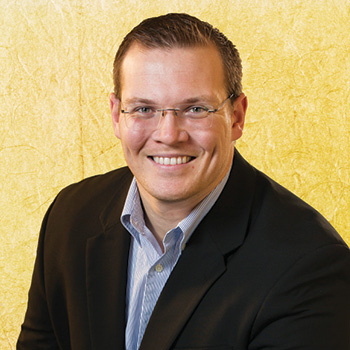Defensive, diversified, dynamic

Tony Hellenbrand, RICP • Green Bay, WI
Safeguard Wealth Management
Read full biography below
It was all the more interesting and challenging since part of our time running the portfolio was smack in the middle of a financial crisis. We started the process from square one, looking at allocations between equities, fixed income, and cash, and then had to consider levels of exposure and specific investment selections.
The experience taught us how to manage under pressure and why one should not make decisions based on fear and panic. The interaction between the group was also important, and I think there was a valuable lesson there related to the advisory business about the importance of clients having a sounding board, especially in times of market stress. We were quite successful and won national recognition as measured by risk-adjusted returns, evaluated in a pool of over 200 teams in the competition from around the country.
I strongly believe in alignment of our values and objectives with what best serves clients: clarity and transparency, upholding a fiduciary standard, independence in our planning and investment recommendations, and empowerment and education. These all play out in the advisory nature of our practice and the ability to bring world-class solutions from a variety of sources to clients.
We have three key words that sum up what we are looking for in managers: defense, diversification, and dynamic. These are probably pretty obvious to professionals in the industry, but not necessarily to clients, and I discuss them thoroughly.
 I talk about the three elements that define active management for me. Defense or risk management is at the top of our priority list. Some people may believe that the 2007–09 credit crisis was a once-in-a-lifetime event, and perhaps they are right that that specific type of event may not occur soon again. But when they review the research on market cycles, they can see statistically that someone can expect to face four to six major bear markets in the next 25 years. Major market drops of 20%, 30%, or more are not events that happen once in a millennium, and they can have devastating effects on a retiree’s portfolio. That is why good defense is required.
I talk about the three elements that define active management for me. Defense or risk management is at the top of our priority list. Some people may believe that the 2007–09 credit crisis was a once-in-a-lifetime event, and perhaps they are right that that specific type of event may not occur soon again. But when they review the research on market cycles, they can see statistically that someone can expect to face four to six major bear markets in the next 25 years. Major market drops of 20%, 30%, or more are not events that happen once in a millennium, and they can have devastating effects on a retiree’s portfolio. That is why good defense is required.
That leads to the next point on diversification. Diversification should work at many levels: (1) through the bucket approach to planning, so different roles and risk levels are established for different portions of a client’s assets; (2) diversification across asset classes; and (3) diversification across strategies and even managers. The last concept relates to dynamic risk management of portfolios. Markets are not static, I tell clients—and they usually nod their heads—why should the management of investments be static? Money should be managed in a way that can withstand the ups and downs of those market cycles I referred to. Even clients with 30-year time frames need to be aware of this.
So we want managers who have a dynamic approach to money management. That usually means managers who employ a sophisticated quantitative approach with a rule set based on algorithms and models, and managers who use a team approach with different substrategies or elements of the portfolio managed by different individuals. I have used many types of managed approaches, based on what is right for a specific client. These managers have the ability to trade daily, to get in and out of the market, use a variety of asset classes, and can go to cash or bonds or even be positioned inverse to the market. That is what I mean by dynamic, and I try to explain that as simply and thoroughly as possible.
 Tony Hellenbrand has been managing wealth for individuals and institutions since 2007. He is a partner at Safeguard Wealth Management, a fee-based advisory firm and registered investment advisor located in Green Bay, Wisconsin.
Tony Hellenbrand has been managing wealth for individuals and institutions since 2007. He is a partner at Safeguard Wealth Management, a fee-based advisory firm and registered investment advisor located in Green Bay, Wisconsin.
An honors graduate of Michigan Technological University, where he studied business administration and finance, Mr. Hellenbrand was part of a team of students that managed a live money portfolio for one of the university’s endowment funds (with assets over $1 million). He and the team earned national recognition for their efforts on behalf of the Applied Portfolio Management Program. After graduation, Mr. Hellenbrand spent the early years of his career working for a private investment firm in Connecticut.
Mr. Hellenbrand has been quoted frequently in the business media, including Forbes, The Wall Street Journal, and CNBC. He is a strong advocate for protecting clients’ rights, especially regarding their retirement plans. In an interview with FiduciaryNews.com, he stated, “It’s too bad that always acting in the best interests of the client has to be forced upon the industry by the DOL. It should be the whole reason an advisor is in business. I think acting in the best interest of the client is as self-explanatory as a definition gets.”
Mr. Hellenbrand and his wife live in De Pere, Wisconsin, and they enjoy spending time with their extended family. Outside of work you can also find him fishing, hunting, or golfing, “as long as the Wisconsin Badgers or Green Bay Packers do not have a game.” While he has a strong retirement planning practice, he is very interested in new ways of marketing his firm to younger generations and actively uses social media, blogging, and the latest technologies to engage this audience.
Disclosure: Safeguard Wealth Management is a registered investment advisor in the state of Wisconsin.
Photography by Mike Roemer


